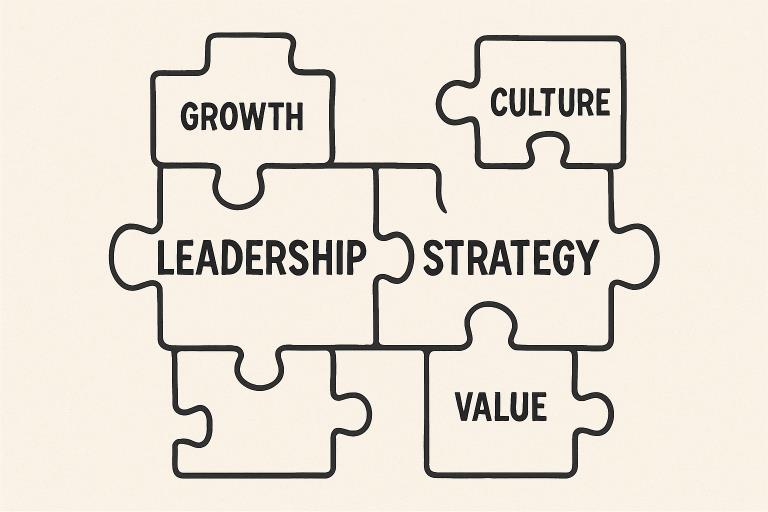Now Reading: Why Leadership Fit Matters in Private Equity Portfolio Companies
-
01
Why Leadership Fit Matters in Private Equity Portfolio Companies
Why Leadership Fit Matters in Private Equity Portfolio Companies

Key Takeaways
- Leadership alignment is a cornerstone for value creation and mitigating risk in PE portfolio companies.
- Soft skills, such as emotional intelligence and adaptability, are becoming increasingly indispensable for C-suite executives.
- Strong succession planning is essential for maintaining momentum and organizational continuity.
Strong leadership is one of the most critical drivers of success within private equity portfolio companies. Beyond technical expertise, leaders must demonstrate the agility to navigate complex transformations, align teams around value-creation goals, and adapt to evolving market pressures. A leader who aligns with the company’s culture and strategic vision can accelerate growth, foster innovation, and ensure the smooth execution of operational improvements. Conversely, misaligned leadership can hinder progress, damage morale, and reduce the investment’s potential return.
Identifying leaders who not only possess strong management skills but also align with the firm’s mission and long-term strategy requires a thoughtful and data-driven approach. This is where private equity executive search becomes vital—it focuses on finding individuals who can thrive in high-stakes, performance-driven environments. By prioritizing leadership fit from the outset, investors can build resilient teams that drive sustainable success across their portfolio companies. Ultimately, the right leadership match enhances operational efficiency, strengthens organizational culture, and maximizes value creation over the investment lifecycle.
The Importance of Leadership Alignment
Leadership alignment refers to the degree to which the vision, culture, and capabilities of an executive team match the strategic objectives of the company. For private equity-backed organizations, this alignment is indispensable. According to insights from McKinsey & Company, leaders in PE companies face unique demands: limited autonomy, a strict focus on value creation, and often, the need for cultural revitalization. A leadership team that lacks alignment with these requirements can undermine growth and slow down the execution of mission-critical plans.
Private equity sponsors often operate within high-pressure, finite hold periods with defined exit targets. As a result, cracks in leadership fit and alignment surface quickly, translating to operational drag and even investor dissatisfaction. When leadership teams are intentionally chosen for alignment with a portfolio company’s growth strategy, the transformation occurs more quickly and yields more tangible results.
The Rising Importance of Soft Skills in Leadership
Historically, PE firms evaluated talent based on technical and financial acumen. As the operating environments have become more complex and competitive, these criteria have expanded to include soft skills—most notably, emotional intelligence, self-awareness, and resilience. These qualities empower leaders to navigate uncertainty, motivate teams, and build trust with stakeholders even in adverse circumstances.
Empathy, active listening, and the ability to manage conflict are now seen as essential cultural multipliers, especially when companies undergo rapid change or restructuring. These soft skills not only enrich internal culture but also have a measurable impact on financial returns by fostering stability and higher engagement during times of transition.
Succession Planning: Mitigating Leadership Transition Risks
Leadership transitions are a natural part of any company’s lifecycle, but in PE-backed firms, the stakes are exceptionally high. Ineffective or poorly timed succession can lead to performance dips, disruption, and even erosion of hard-earned enterprise value. According to insights compiled by Vantyr Group, integrating structured onboarding and executive coaching within the first 180 days of a new leader’s tenure substantially boosts the chances of a successful transition.
In addition, proactive team interventions and leadership assimilation strategies can smooth communication, reinforce strategic alignment, and establish a foundation for long-term leadership success. For PE firms, robust succession planning not only future-proofs investment but also reassures LPs and stakeholders of organizational stability throughout transitional periods.
Case Studies: Successes and Failures in Leadership Fit
Examples from recent private equity deals illustrate the tangible outcomes—both positive and negative—of leadership fit. Following Blackstone’s acquisition of Hilton Worldwide, a keen focus was placed on redefining the business model and modernizing management practices. The result was a significant increase in company value, followed by a highly successful exit.
Compare this with TPG’s investment in J. Crew, which struggled due to leadership misalignment and an inability to navigate periods of transformation. This ultimately resulted in operational decline and bankruptcy. These cases showcase the direct line between strategic leadership fit and investment returns for private equity sponsors.
Strategies for Aligning Leadership with Organizational Goals
- Comprehensive Evaluation Processes:PE firms increasingly supplement financial due diligence with evaluations of leadership style, values, and strategic outlook. This holistic approach uncovers deeper fits and misalignments early, preventing future value erosion.
- Emphasis on Soft Skills:Focusing on capabilities like empathy, communication, and resilience leads to better integration and culture formation—especially crucial in turnaround scenarios or accelerated scaling.
- Robust Succession Planning:Formal succession frameworks and transparent CEO pipeline management provide reassurance and facilitate smoother executive transitions, enabling continued performance even in the face of short-term disruptions.
- Continuous Leadership Development:Investing in coaching, executive education, and leadership assessments ensures that the executive team’s skills consistently align with the organization’s evolving strategy and market realities.
Conclusion
For private equity firms and their portfolio companies, the quality and alignment of leadership teams are fundamental determinants of long-term success. Leveraging strategic leadership searches, prioritizing both soft and hard skills, and embedding succession planning into organizational DNA all translate to greater value creation, lower transition risk, and better investment outcomes. Strong leadership alignment is not just a best practice—it is a necessity for sustainable growth in a demanding and ever-evolving sector.





















